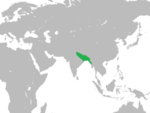Shamsuddin Ahmad Shah
| Shamsuddin Ahmad Shah | |||||
|---|---|---|---|---|---|
| 8th Sultan of Bengal | |||||
| Reign | 1433–1436 | ||||
| Predecessor | Jalaluddin Muhammad Shah | ||||
| Successor | Nasir Khan (usurper) Nasiruddin Mahmud Shah | ||||
| Born | Ahmad ibn Muhammad 1419 Sonargaon, Bengal Sultanate | ||||
| Died | 1436 (aged 16–17) Sonargaon, Bengal Sultanate | ||||
| |||||
| House | Ganesha dynasty | ||||
| Father | Jalaluddin Muhammad Shah | ||||
| Religion | Sunni Islam | ||||
| Part of a series on the |
| Bengal Sultanate |
|---|
 |
Shamsuddīn Aḥmad Shāh (Bengali: শামসউদ্দীন আহমদ শাহ, Persian: شمس الدین احمد شاه; r. 1433–1436) was the last Sultan of Bengal belonging to the House of Ganesha. He was the son and successor of Sultan Jalaluddin Muhammad Shah. After his father's death, he ascended the throne at the age of 14.[1]
Early life
[edit]Ahmad was born into the ruling family of the Bengal Sultanate, during the reign of his father Jalaluddin Muhammad Shah in 1419. They belonged to the Ganesha dynasty, and Ahmad's grandfather was Raja Ganesha, a Bengali Hindu. Ahmad's father had become a Muslim in 1415 and so Ahmad was born a Bengali Muslim.[1]
Reign
[edit]
Ahmad's father died in Rabiʽ al-Thani 837 AH (November/December 1433 CE) and so Ahmad ascended the throne at 14 years of age.[2]
The Muazzampur Shahi Mosque, adjoining the dargah of Shah Alam Shah Langar, in Muazzampur, Sonargaon was built during the reign of Ahmad Shah.[3] The Persian inscription mentions officers by the name of Firuz Khan and Ali Musa Sultan.[4][5]
According to Firishta, he followed the liberal policy of his father and was known for justice and charity.[6] His father had good ties with Barsbay,[7] a Mamluk sultan who had gifted Jalaluddin with investiture, a robe of honour and a letter of recognition.[8][9] Jalaluddin had died before his own gifts could be dispatched to Barsbay, and so the job was left for Ahmad Shah to complete. Ahmad Shah had slightly delayed the dispatching but nevertheless sent the initial gifts of his father off whilst also adding more gifts of his own.[10] In total, the package was worth over 12,000 red tankas and included clothes, cotton, ginger, myrobalan and other spices. The envoy, travelling from Bengal to Cairo via the Indian Ocean, sank whilst at Jeddah's coast. In 1436, the Governor of Jeddah sent some men to search the Red Sea for the gifts and they came back with the textiles although the spices were damaged by the water. After Barsbay was informed of this by the Governor, he ordered for the arrest of all members of the Bengali embassy, the confiscation of their envoy's merchandise, and banned them from ever travelling to Cairo again.[11]
Death
[edit]Ahmad Shah ruled for only 3 years and had no heirs. His reign was marked with chaos and anarchy including an invasion led by Ibrahim Shah Sharqi. He was buried in the Eklakhi Mausoleum with his mother and father.[12]
Contemporary historian Firishta mentions that one of Ahmad Shah's attendants, "Nasir ad-Din Ghulam", seized the throne after his death. 18th-century historian Ghulam Husain Salim claims that Ahmad himself was killed by two of his attendants, Shadi Khan and Nasir Khan,[1] who fought amongst themselves with Nasir Khan usurping control.[13] The nobles of Bengal managed to depose Khan within his short reign of either seven days, half a day or a few hours. The nobles subsequently installed to the throne a farmer named Mahmud, after realising that he descended from the Ilyas Shahis, the inaugural ruling dynasty of Bengal.[6][14]
See also
[edit]References
[edit]- ^ a b c Taher, MA (2012). "Shamsuddin Ahmad Shah". In Sirajul Islam; Miah, Sajahan; Khanam, Mahfuza; Ahmed, Sabbir (eds.). Banglapedia: the National Encyclopedia of Bangladesh (Online ed.). Dhaka, Bangladesh: Banglapedia Trust, Asiatic Society of Bangladesh. ISBN 984-32-0576-6. OCLC 52727562. OL 30677644M. Retrieved 16 January 2025.
- ^ Taher, MA (2012). "Jalaluddin Muhammad Shah". In Sirajul Islam; Miah, Sajahan; Khanam, Mahfuza; Ahmed, Sabbir (eds.). Banglapedia: the National Encyclopedia of Bangladesh (Online ed.). Dhaka, Bangladesh: Banglapedia Trust, Asiatic Society of Bangladesh. ISBN 984-32-0576-6. OCLC 52727562. OL 30677644M. Retrieved 16 January 2025.
- ^ Muazzam Hussain Khan (2012). "Muazzampur Shahi Mosque". In Sirajul Islam; Miah, Sajahan; Khanam, Mahfuza; Ahmed, Sabbir (eds.). Banglapedia: the National Encyclopedia of Bangladesh (Online ed.). Dhaka, Bangladesh: Banglapedia Trust, Asiatic Society of Bangladesh. ISBN 984-32-0576-6. OCLC 52727562. OL 30677644M. Retrieved 16 January 2025.
- ^ Ahmad Hasan Dani (1957). "Analysis of the Inscriptions". Asiatic Society Of Pakistan Vol-ii. pp. 38–41.
- ^ Siddiq, Mohammad Yusuf (19 November 2015). "Inscriptions of the Sultanate period". Epigraphy and Islamic Culture: Inscriptions of the Early Muslim Rulers of Bengal (1205-1494). Routledge. p. 139.
- ^ a b Majumdar, R.C. (ed.) (2006). The Delhi Sultanate, Mumbai: Bharatiya Vidya Bhavan, p.211
- ^ MA Taher (2012). "Jalaluddin Muhammad Shah". In Sirajul Islam; Miah, Sajahan; Khanam, Mahfuza; Ahmed, Sabbir (eds.). Banglapedia: the National Encyclopedia of Bangladesh (Online ed.). Dhaka, Bangladesh: Banglapedia Trust, Asiatic Society of Bangladesh. ISBN 984-32-0576-6. OCLC 52727562. OL 30677644M. Retrieved 16 January 2025.
- ^ Al-Sakhawi. Al-Daw al-lami' li ahli al-Qarni al-Tasi (in Arabic).
- ^ ʻAbdallāh Muḥammad Ibn-ʻUmar al-Makkī al-Āṣafī al-Ulughkhānī Hajjī ad-Dabir. Zafar ul wālih bi Muzaffar wa ālihi (in Arabic).
- ^ Abdul Karim (1960). Corpus of the Muslim Coins of Bengal: (down to A. D. 1538). Asiatic Society of Pakistan.
- ^ Behrens-Abouseif, Doris (16 May 2014). Practising Diplomacy in the Mamluk Sultanate: Gifts and Material Culture in the Medieval Islamic World. Bloomsbury Publishing. pp. 9, 29, 46.
- ^ "Adina Masjid". ASI, Kolkata Circle. Retrieved 3 April 2019.
- ^ Salim, Gulam Hussain; tr. from Persian; Abdus Salam (1902). Riyazu-s-Salatin: History of Bengal. Asiatic Society, Baptist Mission Press. p. 119.
- ^ Ferishta, Mahomed Kasim (January 2016). Briggs, John (ed.). History of the Rise of the Mahomedan Power in India, Till the Year AD 1612. Vol. 4. Oriental Books. p. 199.
